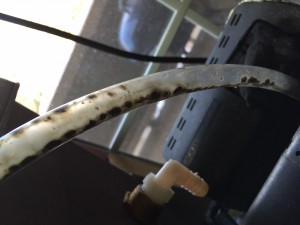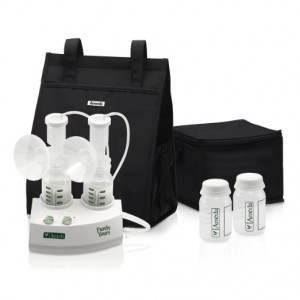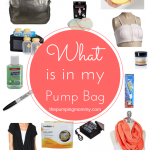If you are like me, then you likely have never heard of a closed system breast pump. What is it? Why didn’t I know about it? And how do I find one?

Mold growth in pump tube
When I first heard of a closed system pump, I immediately took to the internet to find out what the heck was going on and why I had no idea if my pump was closed, open, or sideways…
What the heck does a closed system pump mean?
Well, let me assure you that it is quite simple to understand. When looking at most pumps, they appear very similar.
All of them have a pump motor and some form of tubing that connects the motor to the milk collection kit (flanges or breast shields and milk bottles). But not all pumps are made equal.
Some pumps are an open system and some are closed system.
A closed system pump has a barrier between the motor and the milk collection kit that keeps the milk from entering the tubing. An open system pump does not have a barrier which can allow some milk particles to enter the tubing and potentially lead to mold.
Open System Breast Pumps
In open system pumps, the end of the tubing that is attached to the milk collection kit is open and, therefore, can allow milk to pass into the tubing and ultimately into the pump motor.  As stated above, the biggest issue with this design is that it can lead to mold growth within the tubing.
As stated above, the biggest issue with this design is that it can lead to mold growth within the tubing.
If the tubes are not properly cleaned, then the mold particles can be exposed to your breast milk.
The key phrase there was cleaned properly. Open system pumps are not as horrifying as they may sound. But, like all products that you use to feed your baby, they require proper cleaning and maintenance.
The tubing should be properly dried out after each pumping session. This can be done by letting the pump run for a few minutes after you have finished pumping. This “dry pumping” helps pull air through the tubing and dry it out. Isopropyl alcohol can be used by adding a few drops to the tubing but be careful to let it dry before pumping again as the vapors can be exposed to your milk.
 Another option mothers opt to use is to boil the tubing parts to sanitize them. The only issue I have found with this method is after time the tubes become cloudy and that makes it hard to detect any moisture in the tubes.
Another option mothers opt to use is to boil the tubing parts to sanitize them. The only issue I have found with this method is after time the tubes become cloudy and that makes it hard to detect any moisture in the tubes.
I have owned a few open system pumps and have not had an issue with mold. I boiled my tubing two times a week along with other pump parts since I used my pump multiple times per day. I also opted to replace the tubing every 3-4 months.
With proper care, mold should not be an issue with an open system pump. If you neglect to clean your pump parts, then yes, you will likely get mold.
(Related: Click here to visit our Pump Part Replacement Page to get extra Tubing for your Medela Pump.)
Closed System Breast Pumps
A closed system pump has a barrier between the tubing and the milk collection kit. This barrier keeps outside air and milk from passing into the tubing. This means the tubing never requires cleaning and there is no possibility of mold growth.
Closed system pumps were originally created for hospital grade pumps because they had multiple users. The closed system pump ensured that no bacteria or viruses from one user could pass to another since the pump could be properly cleaned.
Even though the intent of a closed system pump was to allow multiple users, all personal pumps should be considered single user products unless directed by the manufacturer.
List of Closed System Pumps
If you are interested in a closed system pump, here is a list.
- Ameda Elite
- Ameda Purely Yours
- Playtex Embrace
- Bailey Medical Nurture III
- Evenflo Comfort Select Dual
- First Years Natural Comfort Double
- Lansinoh Double Electric
- Avent ISIS iQ Uno
- Avent ISIS iQ Uno Complete
- First Years Natural Comfort Single
- Medela Swing
- Hygeia EnDeare
- Hygeia EnJoye-LBI
- Hygeia EnJoye-EXT
- Hygeia EnJoye-EPS
- Spectra 9
- Spectra S1
- Spectra S2
(Related: Click here to see a complete list of Breats Pump Reviews and find the right one for you!)
To Closed System Pump, Or NOT to Closed System Pump?
So is a closed system pump better than an open system pump? In my opinion, no.
Really the only difference is the need to clean the tubing on an open system pump and when you are already washing 1,000 parts, what’s another two?
I would not select a pump based solely on it being a closed system pump. If it was a pump that I really liked and it also happened to be a closed system, then great! But there are many, many fantastic pumps on the market that are open system pumps that I would choose over many of the closed system pumps.
So, in the end, don’t let the talk of moldy open system pumps scare you. If you have bad hygiene, then yes, be concerned. But most of us have nothing to worry about. Wash your pump parts regularly and you will have a mold-free, squeaky clean pump!
Leave us a comment and share your thoughts on open versus closed system pumps!
Related Articles




great post. Thanks for sharing with us
I am glad you found it helpful! Thank you for visiting!
Great post! I had trouble breastfeeding and resorted to pumping for the first month. There is definitely a lot of maintenance involved to keep everything clean and ready for multiple use.
I had no idea there was a difference in pump tubes. I honestly chose my breast pump based on friends reviews and the highest ratings.
Now that I know, I will be sure to pass the info along to other mom friends who may be in search of a breast pump.
Thanks for sharing!!
Not many moms know that there are different types of pumps in regards to open vs closed. I certainly didn’t know! Now that I’m educated on the subject, I am shocked that this is not something that is highlighted for moms when buying a pump. Most know that pump manufacturers say not to share pumps with multiple users but most don’t know the reason behind why. I am glad that I could enlighten you!
I will totally recommend others to go for Closed System Breast Pumps from now on. Because i think most people will forget to clean the last two parts 😉 This site was great and informative.
And isnt a closed system breast pump easier to clean if you are always on the go?
Keep up the good work
Yeah the sight of mold in the tubing sends most people running for a closed system pump haha. There are several parts that need to be cleaned daily on the pump – breastshields, valves, membranes, milk bottles, etc so honestly what’s two more? And the tubing doesn’t need to be cleaned daily.
I recommend letting the pump run for a few minutes after a pumping session (while not connected to a breastshield or milk collection kit) to dry out the tubing. Then boil the tubing 2 times a week to sanitize. You honestly should be boiling the pump parts about that often anyway.
I never had a mold issue following this method! And I didn’t feel it was any more work. But if people will forget or don’t want the trouble, then closed system is the way to go!!
HI Heather,
thank you for yet another very useful article. I must say I was stumped when reading about all these different types of pumps initially. Your post has helped it make a lot more sense to me now though. I am expecting my first so am a complete newbie to all this stuff. Does pumping hurt?
It can certainly be overwhelming!! Congratulations on your first baby! How exciting!
Pump should NOT hurt! It honestly just feels like a gentle tug at your breast. If you do pump shortly after your baby is born, your nipples may still be sore from starting to breastfeed/bad latch/etc so you may feel some discomfort when pumping but that will go away just like the soreness in your nipples when you breastfeed.
But typically if you have any pain or discomfort when pumping, it is due to the breastshield (the pump piece that goes over your breast) not fitting properly. You would probably need a bigger size. A lactation consultant can help you find a proper fitting breastshield if you need assistance.
Best wishes to you and I hope to see you back here again soon!
Hello Heather Grace,
This is a very informative article. I like your niche, you don’t find a lot of info about this niche nowadays.
Both my boys were born preemies and had a hard time latching on. I was a pumping mom like you. Because both my boys were born tiny (less than 4 and 5 lbs) i wanted them to have all the nutrients they could get from mothers milk. Problem was I was a Home Health Nurse and had to go back to work. So I was lugging my Medela Duo electric pump and yes, pumped all over Northern Chicago. At work, Babies/Toys r us, even Parking lots and I would come home with jugs of milk 🙂 It was hard work! But My boys are now 13 and 10, happy and healthy.
Kudos on a great website but most of all, kudos on being a super pumping mommy.
Ann
Wow! You are super mom! I know what it’s like to drag that pump everywhere. I love that there are some light weight pumps on the market now that fit in your purse. I wish I had known that with my first baby! And I agree that there isn’t enough information out there on pumping. That was why I started this site! Thank you so much for stopping by and glad you found the information useful!
Hi Heather,
What a great idea to write about breast pumps! That topic would have never crossed my mind! Like you, I never knew there was a difference between them. I just thought a breast pump was a breast pump!
The image of the tube with the mold looked disgusting. I can’t imagine anyone letting their breast pump to get like that; let alone use milk from it.
I don’t personally, have any need for them at my age, but my 3 granddaughters are in their child-bearing years and I will definitely refer them to you website. You have a lot of interesting information here.
Thanks for taking the time to write about it.
Yes, it shocked me that people actually built up enough mold (which is clearly visible) to get a picture of it! So gross! I think the idea of mold seems to turn people off of open system pumps but truthfully it’s all in how you take care of it!
Thank you for your comment!
This is a really great post.
I wasn’t aware of open or closed breast pumps but I can see how mold can be an issue.
Out of interest, is there a price different between open and closed pumps?
If you was to recommend a breast pump be it open or closed, which would you go for?
Sammi
There is not a price difference just because a pump is a closed system pump, no. There are some very affordable closed system pumps as well as open system pumps. If I had to pick one closed system pump as my favorite, it might be the Ameda Purely Yours.
But honestly, I don’t see being a closed system pump vs an open system pump a deal breaker either way. My two favorite pumps are the Medela Pump in Style and Medela Freestyle. Both open system pumps. I would rather have one of these two amazing pumps and deal with washing the tubing, then chose a pump I feel is not as good just because it boasts a closed system. Just my personal opinion.
Thank you for your question!
You’ve definitely put a lot of work into defining your niche. I applaud you highly. I never would have thought of a breast pump niche.
Now to your article, again here you’ve put in a lot of work to come up with a thoroughly researched article. This is awesome. Great job on everything.
Thank you, Dan. After breastfeeding two children while working, pumping was a huge part of my life so it feels natural to talk about it! Thank you for stopping by!